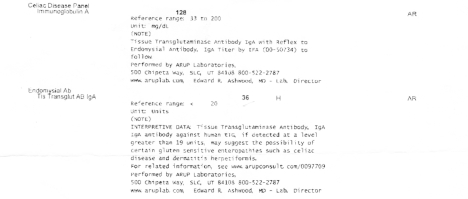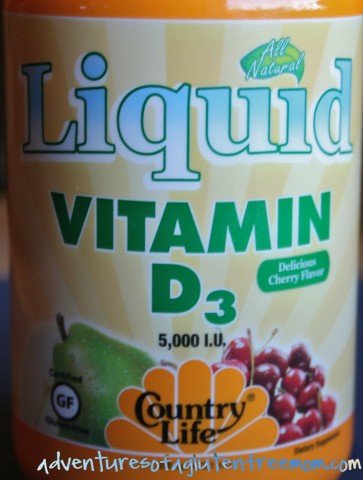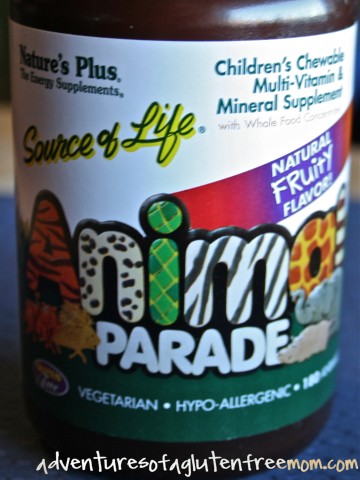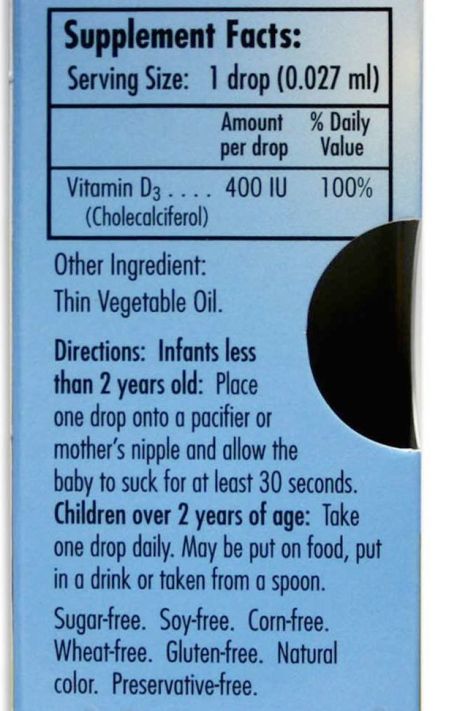I want to share a few videos that really struck a chord with me because of my own personal journey through the land of autoimmune disease and undiagnosed gluten sensitivity.
*I am not a doctor or any other trained medical professional for that matter, so please keep that in mind. My blog is a personal blog and I am just a 36 year old mom who has celiac disease, dermatitis herpetiformis, Graves’ Disease and have also been diagnosed with a slew of other medical issues over the course of my life. Because I did not exhibit the “classic” symptoms of celiac disease, none of my doctors ever thought to look beyond the scope of my symptoms to find the underlying cause.
I have undertaken a medical odyssey for answers and truth, wherever they may be found (of course when it comes to celiac disease, that always seems to be a moving target). 😉 I am just curious about my story, and how I managed to slip through the cracks for so long. I thought I would share the information I am learning along the way, in the hopes that if any of this strikes a cord with someone who hasn’t been diagnosed with gluten sensitivity yet, that they might get tested. I can’t imagine how different things could have been had I been diagnosed with gluten sensitivity BEFORE it turned into celiac disease. The sooner one finds out that they are gluten sensitive, the better they will be in the long run. One’s health is a heavy price to pay for food that may unknowingly be toxic to you.
There is more available information on gluten sensitivity today than there was even just a year ago. I personally find the whole “spectrum of gluten sensitivity,” which includes celiac disease and dermatitis herpetiformis, to be utterly fascinating. If you think you have an issue with gluten, but your tests for celiac disease come back “negative,” you may find some valuable information in what Dr. Petersen has to say. The first video pertains to autoimmune disease (as a whole) and gluten sensitivity.
The following video is more specific to autoimmune thyroid disease and gluten sensitivity:
I was diagnosed with Graves’ Disease in 2004 and this was the upteenth diagnosis that I had received over a lifetime of unexplained medical oddities. This diagnosis finally set me on the path to discovering my “hidden” celiac disease. I was diagnosed with Graves’ Disease after a sore on my leg, would not heal. My primary doctor initially suspected Type 2 Diabetes, because diabetics can have problems with wound healing. After she ran a blood test (which came back negative for diabetes), she called me to say that my thyroid came back “high,” in fact, extremely high. I had no idea what that meant at the time, so she referred me to an endocrinologist to check it out further.
The first tests “Dr. G” ran on me, to see what was going on with my thyroid, included (the “normal reference ranges” that I list, were for 2004):
- Total T3 (my score: 221, with the normal reference range of 57 – 175).
According to WebMD, the Total T3 test is:
Triiodothyronine (T3). Most of the T3 in the blood is attached to thyroxine-binding globulin. Less than 1% of the T3 is unattached. A T3 blood test measures both bound and free triiodothyronine. T3 has a greater effect on the way the body uses energy than T4, even though T3 is normally present in smaller amounts than T4.
- Anti-TPO-Ab (my score: 428 with the normal reference range of 0 – 34).
According to the Mayo Clinic:
TPO, an enzyme normally found in the thyroid gland, plays an important role in the production of thyroid hormones. A thyroid peroxidase test detects antibodies against TPO in the blood. The presence of thyroid peroxidase antibodies in your blood suggests that the cause of thyroid disease is due to an autoimmune disorder such as Hashimoto’s disease or Graves’ disease. In autoimmune disorders, your immune system makes antibodies that mistakenly attack normal tissue. Antibodies that attack the thyroid gland cause inflammation and impaired function of the thyroid.
- Thyroid Stimulating Immunoglobulin (my score: 186, with the normal reference range of 0 – 129).
According to Johns Hopkins University:
Thyroid stimulating immunoglobulins, also known as TSIs, are autoantibodies that are produced by the immune system in the setting of Graves’ disease.
- FT4 (my score: 1.5, with a normal reference range of 0.8 – 1.6).
According to WebMD:
Free thyroxine (FTI or FT4). Free thyroxine (T4) can be measured directly (FT4) or calculated as the free thyroxine index (FTI). The FTI tells how much free T4 is present compared to bound T4. The FTI can help tell if abnormal amounts of T4 are present because of abnormal amounts of thyroxine-binding globulin.
- TSH (my score: 0.021, with a normal reference range of 0.4 – 4.5).
According to MedlinePlus:
TSH is a laboratory test that measures the amount of thyroid stimulating hormone (TSH) in your blood. TSH is produced by the pituitary gland and tells the thyroid gland to make and release the hormones thyroxine (T4) and triiodothyronine (T3).
*If you have ever been confused on the TSH test (it took me forever to understand why a “low” TSH number (like my 0.021) indicated a “high” thyroid (hyperactivity), click here for a great article explaining it!).
Apparently, my scores were “good” enough for Dr. G to diagnose me with Graves’ Disease! All I can remember thinking to myself, as I sat in his office and heard the words “Graves’ Disease,” was “oh no, my eyes are going to “bug out.” Seems silly to me now, but that was all I knew of the disease back then. It was enough to reduce me to tears and ask what was the best way to make sure that didn’t happen . I also wanted to know if I would ever be able to have another baby, and if so, what was the most efficient treatment to get me to that point as fast as possible. Dr. G recommended Radioactive Iodine Ablation, so that’s what I did.
Over the next 10 months, after my thyroid “died” and I was put on a thyroid replacement hormone, my TSH levels began to soar, reaching an eventual high of around 150, despite being on a very high dose of Levoxyl and a T3 hormone, Cytomel. It felt as though the life were being sucked right out of me. I was extremely lethargic and put on a ridiculous amount of weight. Add to that the fact that I was a relatively new mother at the time and still battling some postpartum “adjustments.” It was utter hell to care for a baby when I barely had the energy to get out of bed, and I quickly found myself in the midst of a deep depression, and was promptly put on antidepressants.
Poor Dr. G., he was seeing me often back then (monthly), and had grown so accustomed to me showing up in tears (I was always assuming that I would get more bad news, like an even higher TSH level than the previous month… I had self-diagnosed myself with “Pavlov’s Dog syndrome,” by this time. 😉 ), that he greeted me each time with a box of tissues! Love that man, it makes all the difference in the world when you have a physician with a compassionate bedside manner.
It was Dr. G. who discovered my hidden celiac disease in April of 2005; after returning from a medical conference and learning “something” that apparently connected a few dots for him, as to why I was not absorbing my thyroid hormone medication. He said he was going to test me for celiac disease. I laughed at him. A few years prior (I cannot recall the exact year, but I believe it was 2000), when I was still in my career as an event planner for a major hotel, I ironically detailed a celiac disease conference. This was back when celiac disease was still thought to be a rare childhood disease, and I can clearly remember thinking to myself, “Whew… I am in my mid-20’s, I do not suffer from stomach aches and diarrhea and I am not super skinny. I am in the clear for celiac disease!” Little did I know that I should have been one of the conference attendees.
The initial blood test that Dr. G ran on me was not the current “Celiac Panel,” that is outlined on The University of Maryland Center for Celiac Research website. Those tests include the following:
- Total IgA
- AGA-IgG or Antigliadin IgG
- AGA-IgA or Antigliadin IgA
- tTG-IgA or tissue transglutaminase-IgA
Dr. G only tested me for the presence of Anti-Gliadin Antibodies, and the following results are from my April, 2005 blood test:
- Gliadin IgG Ab (my score: 25.2, with a normal reference range of 0 – 29.9)
- Gliadin IgA Ab (my score: 42.7, with a normal reference range of 0 – 29.9)
Based on those results alone, Dr. G gave me the diagnosis of celiac disease and did not recommend putting me through the intestinal biopsy to confirm it (although I ultimately had two intestinal biopsies and a skin biopsy before I came to terms with the truth. I really struggled with the fact that I did not “feel sick”).
I had the celiac panel run again in September of 2009 (I get these occasionally to see “whats going on inside,” because I cannot tell when I have been “glutened”), and this time it was the current celiac panel that my doctor ordered. The following were my results from just 8 months ago:
- Celiac tTG Ab IgA Out of Range, (my score: 37, with a normal reference range of 0 – 19) Apparently, I had been unknowingly ingesting gluten, which only serves as further evidence (to me anyway), that just because you may not feel sick on the outside, does not mean your immune system is not reacting nonetheless! You cannot “outgrow” celiac disease, once you have it, you have it. Do not be fooled into thinking that if you eat gluten and do not feel sick, that you are suddenly cured, because that could not be further from the truth.
I hadn’t noticed the following statement on my blood work before, and am not sure if it is just my local lab that does this or not :
“The American Gastroenterology Association recommends that “In the primary care setting, the IgA tTG A is the most efficient single serologic test for the detection of celiac disease. Evidence indicates that the additional inclusion of IgG antigliadin antibody and IgA antigliadin is not warranted.” Gastroenterology 2006: 131: 1977 – 1980
To identify patients with selective IgA deficiency, samples are screened using quantitative IgA, followed with tissue transglutaminase antibodies (tTGA).
Antigliadin antibodies may be performed if indicated.
So my question is this, if only 2 components of the panel are routinely tested; how many people (that would fall within the broader spectrum of gluten-sensitivity), are falling through the cracks??
I read this note on The University of Chicago Celiac Disease Center website:
Anti-gliadin antibodies (AGA-IgG and AGA-IgA) are no longer used to test for Celiac Disease due to a low level of accuracy in people who have not yet been diagnosed.
I suppose that makes sense if a physician is looking to diagnose celiac disease. But here is another question, how long does it take for a person to be reacting to gluten, to produce villous atrophy? I have dermatitis herpetiformis, which I am coming to realize I have had for a very long time. According to the Gluten Intolerance Group (bold emphasis added):
Dermatitis Herpetiformis (DH) is a chronic disease of the skin marked by groups of watery, itchy blisters. The ingestion of gluten (a protein contained in wheat, rye and barley) triggers an immune system response that deposits lgA antibodies under the top layer of skin. IgA antibodies are present in affected as well as unaffected skin. DH is a hereditary autoimmune disease linked with gluten intolerance. If you have DH and do not follow a gluten-free diet, you may develop the intestinal damage of celiac disease. With DH, the primary lesion is on the skin rather than the small intestine. The degree of damage to the small intestine is often less severe or more patchy than for those with only celiac disease. Both diseases are permanent and symptoms/damage will occur after consuming gluten.
I do believe that might explain my lack of digestive complaint.
Dr. Petersen talks about testing for gluten sensitivity in the following video:
I really keyed in on what Dr. Petersen said about:
Endomysial and anti-tissue transglutaminase antibodies being more “apropro” for celiac disease because they are positive when there is already a tremendous amount of destruction in the small intestine.
That statement prompted me to look closer at Sam’s blood test,
which indicated a positive result for tTG- IgA, with a score of 36 (normal reference range < 20). Sam’s intestinal biopsy came back “negative.” It makes me wonder if there was actually zero intestinal damage but rather if the biopsies that were taken, were simply from unaffected areas of his small intestine?
Regardless, I asked Sam’s pediatric GI what I should do. Do I allow Sam to continue eating gluten until there is enough intestinal damage to produce a positive biopsy or do I spare him from the risk of other potential celiac related complications by putting him on the gluten-free diet immediately?
“Dr. N” pulled me aside and said, “If Sam were my son, I would put him on the gluten-free diet immediately.”
So that is exactly what I did. I believe that my job, as his mother, is to get my son to adulthood as healthy as possible. If he wants to challenge the diagnosis later in life, then that will be his choice to make as an adult. My villous atrophy can heal on a strict gluten-free diet, but because of my many years of undiagnosed/untreated gluten sensitivity and the related complications I now have, will be with me for the rest of my life. All which could have been avoided had I only been properly diagnosed as a child.
I just received a copy of the Spring, 2010 issue of Celiac Disease News, from the National Digestive Diseases Information Clearinghouse. The very first article is titled, “Research Highlights Importance of Biopsy Site for Diagnosing Celiac Disease in Children.“ The following is an excerpt from the article:
Researchers from the faculty of medicine at Dalhousie University in Halifax, Nova Scotia, Canada, published findings from a study suggesting that biopsy sample sites should include the duodenal bulb—the section of the duodenum immediately adjacent to the stomach. Over 2 years, Mohsin Rashid, M.D., associate professor of pediatrics, and medical student Andrea MacDonald examined biopsy samples obtained from the duodenal bulb and from sites in the second or more distal—farther along—sections of the duodenum in 35 celiac disease patients ranging in age from 17 months to 18 years. Thirty-one of these children had abnormal distal biopsies and all but two also had abnormal bulb biopsies. More significantly, four children with normal distal biopsies showed effects of celiac disease in bulb biopsies.
“Diagnosis of celiac disease would not have been possible in these four cases with distal duodenal biopsies only,” Rashid wrote in an article that appeared in the October 2009 issue of BMC Gastroenterology. “The optimal strategy for detecting villous changes should include biopsies not only from the distal duodenum but also from the bulb to improve the diagnostic yield,” he concluded.
See what I meant about celiac disease being a “moving target?”
I don’t know about you, but I was always taught to trust that my doctors knew everything there was to know about current medicine. If a doctor told me something was so, I believed them and followed their advice (well, up until I was handed my CD diagnosis, it took me a while on that one!). Because really, how would I know otherwise? I did not go to medical school. Since being diagnosed with CD, I have become hyper-aware of how many physicians are not up-to-date on current celiac disease research, including non-celiac gluten-sensitivity. Just since my own diagnosis, I can cite 3 examples of inaccurate information being transmitted from a doctor to a patient (not intentionally):
1. When my mom asked her doctor to test her for celiac disease, he asked her if she had diarrhea. When she responded “no,” he told her that she could not possibly have it, so it was pointless to test her. My mom had to convince him to give her the blood test by mentioning that her daughter had it (her test was negative 4 years ago).
2. When I initially had Sam screened for CD at the age of 3, his tTG test came back within the normal range. I asked Sam’s pediatrician when I should have him tested again and he told me that he would never have to be tested again because “he would never get it.” I walked away from that appointment rather confused, because I had read otherwise. After a little convincing, he agreed to test Sam again at age 5 and this time his tTG test was positive. It was neat though, after a lengthy conversation with “Dr. C,” he told me it was a valuable learning experience for him because it demonstrated that what he had learned in medical school was outdated.
3. My mom-in-law, who has Hashimoto’s Thyroiditis, asked her GI to test her for celiac disease (who also happens to be my GI). When the test came back negative, she mentioned to our doctor that she had felt better when trialing the gluten-free diet (after she took the blood test), and if that meant she could have non-celiac gluten sensitivity? “Dr. P” said there was no such thing as non-celiac gluten sensitivity because “gluten sensitivity = celiac disease” and her blood test was negative for CD, so her feeling better was only “in her head.”
Have you had any similar experiences? If so, I would love to hear your story.
Filed under: Gluten Sensitivity Education, Information and Resources, Personal GF Learning Experiences, Videos | Tagged: Anti-TPO-Ab, Antigliadin IgA, Antigliadin IgG, Asymptomatic Celiac Disease, Autoimmune Disease, Blood Tests, Celiac Disease News, Celiac Panel, Cytomel, Dermatitis Herpetiformis, Dr. Vikki Petersen, Free Thyroxine, FT4, Gluten Intolerance Group, Gluten Sensitivity, Graves's Disease, Johns Hopkins University, Levoxyl, Mayo Clinic, Radioactive Iodine Ablation, The American Gastroenterology Association, The University of Chicago Celiac Disease Center, The University of Maryland Center for Celiac Research, Thyroid Stimulating Immunoglobulin, tissue transglutaminase-IgA, Total IgA, Total T3, Triiodothyronine, TSH, tTG-IgA | 12 Comments »












































